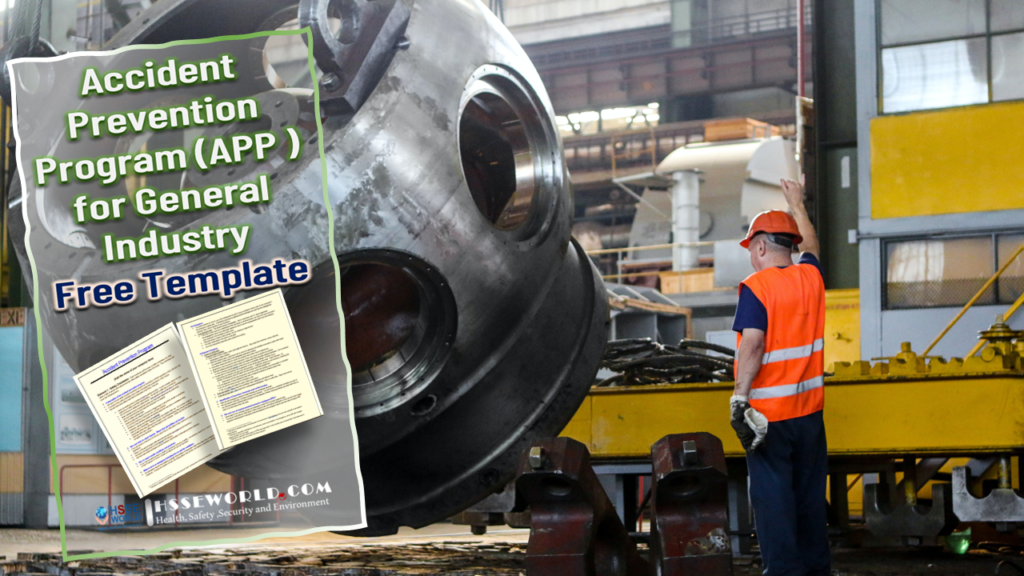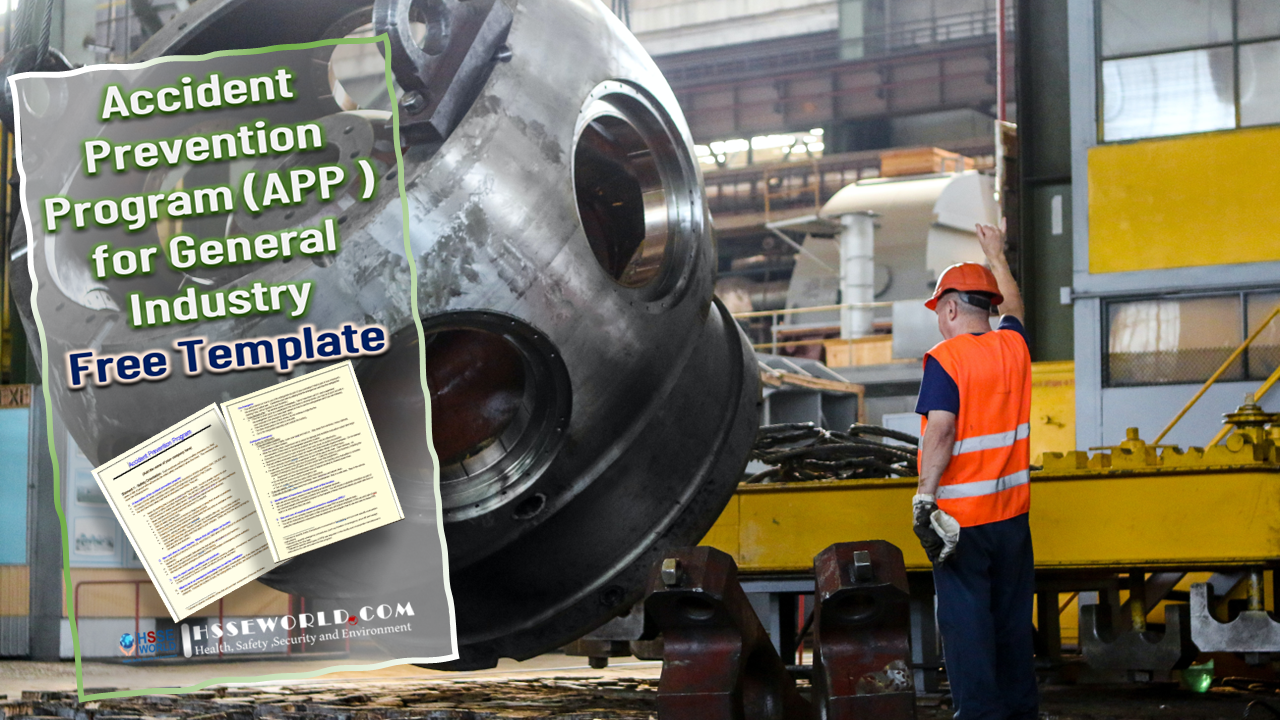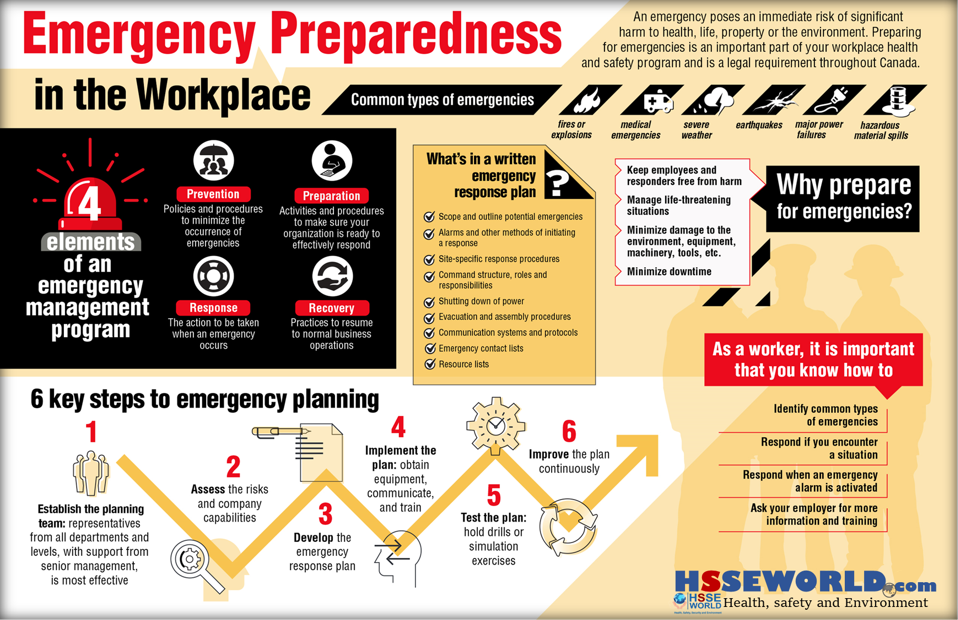Workplace injuries cost employers billions in insurance claims, lost productivity, government fines, and lawsuits every year. Poor workplace-safety practices also provide labor unions a reason for being. Every employer is required to create a written Accident Prevention Program (APP) to address the safety and health hazards found in their workplace. Many employers consider their APP as their cornerstone safety program.
Identifying hazards is the first step to creating an APP. Resources, like the Job Hazard Analysis or the Workplace Hazard Basics course, are available to help you with that task. (use Fast and Easy Method Statement Template )
Minimizing the risk of accidents begins with your own and your management team’s absolute commitment to safety as a core value of the company. This means you do more than just set safety as a priority. Rather, you aim for perfection that is, no job-related accidents leading to injury or death.

Accident Prevention Program Template
What can you do to help ensure that conditions at your company don’t contribute to accidents and huge losses? Think “safety first” and prove your commitment by developing and actively supporting an accident prevention program.
An “Accident Prevention Program” is also often called your “Safety Program. And, the very first rule in the construction rules says you must have one. Your Accident Prevention Program needs to:
- Be written and kept up-to-date.
- Be communicated to workers. This means workers must know the company’s safety rules and procedures.
- Cover all the different hazards that are encountered during your work.
Your accident prevention program is a guide and a resource that tells you about:
- Operating procedures.
- Hazards you may encounter how to recognize the hazards and avoid them.
- Safeguards of tools and equipment.
- Any chemicals or flammables and how to properly handle them.
- Emergency and first aid procedures.
In addition to safety rules, the Accident Prevention Program spells out how safety is managed, like:
- Who is in charge of safety?
- How safety inspections will be conducted.
- How accident investigations will be conducted.
- How employee training will occur.
Your Accident Prevention Program should be an easy-to-read document that you can use to train new workers, to refer to when you have questions, and to guide you safely through the day.
The Template
One of the most effective steps you can take to assure safety-regulation compliance and real workplace safety is to assign an operations manager responsible for a safety program and give that manager authority and resources to make needed improvements.
Here are below Template example guidelines that will help you and your safety manager focus on accident prevention as a core value.
Accident Prevention Program
(Add the name of your company here)
Element 1 – Safety Orientation:
Each employee will be given a safety orientation by (Add name or title of the person who will provide the initial safety orientation) when first hired. The orientation will cover the following items:
- A description of the accident prevention program:
- We have a formal written accident prevention program as described in WISHA regulations (WAC 296-800-140).
- It consists of this safety orientation and a safety committee that is described in Part 2 below.
- We also have basic safety rules that all employees must follow. They are:
- Never do anything that is unsafe in order to get the job done. If a job is unsafe, report it to your supervisor or safety committee representative. We will find a safer way to do that job.
- Do not remove or disable any safety device! Keep guards in place at all times on operating machinery.
- Never operate a piece of equipment unless you have been trained and are authorized.
- Use your personal protective equipment whenever it is required.
- Obey all safety warning signs.
- Working under the influence of alcohol or illegal drugs or using them at work is prohibited.
- Do not bring firearms or explosives onto company property.
- Smoking is only permitted outside the building away from any entry or ventilation intake.
- Horseplay, running and fighting are prohibited
- Clean up spills immediately. Replace all tools and supplies after use. Do not allow scraps to accumulate where they will become a hazard. Good housekeeping helps prevent accidents.
- (Add any other basic safety rules that apply to your company. Delete any from the above list that does not apply to your business.)
Also Read: Photo of the day: New worker Orientation & Safety Orientation checklist
- How and when to report injuries. Where first aid facilities are located.
- If you are injured or become ill on the job, report this to (Add name or title of the person to whom injuries should be reported).
- There is a first aid kit located (Add where the first aid kits are located in your business.)
- We require all supervisors to have first-aid/CPR training. [1]
- We have also posted emergency phone numbers (Add the location of emergency phone numbers).
[1] Tailored to specify the availability of the first aid provider component of first aid facilities.
- How to report unsafe conditions and practices.
- If you see something that is unsafe or someone working unsafely, immediately report it to (Add name or title of the person to whom unsafe conditions should be reported).
- What to do in an emergency including how to exit the workplace.
- An evacuation map for the building is posted (Add the location of the evacuation map if you have one or delete this sentence). It shows the location of exits, fire extinguishers, and first aid kits, and where to assemble outside.
Fire Emergency
- You will be trained on how to use a fire extinguisher as part of your orientation if that is part of your employer’s fire emergency action plan. (Customize your plan by adding how fire emergencies and how fire extinguisher training if any, will be handled in your business.)
- If you discover a fire: [2] Tell another person immediately. Call or have them call 911 and a supervisor.
- If the fire is small (such as a wastebasket fire) and there is minimal smoke, you may try to put it out with a fire extinguisher (only if you have been trained on how to use fire extinguishers and if you are following your employer’s fire emergency action plan).
- If the fire grows or there is thick smoke, do not continue to fight the fire.
- Tell other employees in the area to evacuate.
- Go to the designated assembly point outside the building.
Earthquake Emergency
- During an earthquake:
- If you are inside a building:
- Drop under a desk or table, cover your head, and hold on. Stay away from windows, heavy cabinets, bookcases, or glass dividers.
- When the shaking stops, supervisors are to check for damage and available evacuation routes then begin an evacuation of their area to the designated assembly location.
- Evacuation should proceed as quickly as possible since there may be aftershocks.
- Supervisors must account for each employee in their work group as quickly as possible.
- First, aid-certified employees should check for injuries and help evacuate injured employees. Do not attempt to move seriously injured persons unless they are in immediate danger of further injury.
- If a gas odor is in the building, tell a supervisor to turn off the gas at the main. Open windows. All supervisors are trained in the gas shut-off procedure.[3] (Tailor this section to your business, including the location of emergency shut-off valves and who would have that assignment.)
- Supervisors and first aid employees must not re-enter the building once evacuation is complete.
- Do not approach or touch downed power lines or objects touched by downed power lines.
- Do not use the phone except for emergency use.
- Turn on the radio and listen for public safety instructions.
- If you are outside: Stand away from buildings, trees, telephones,s, and electric lines.
- If you are on the road: Drive away from underpasses/overpasses. Stop in a safe area. Stay in the vehicle.
- Identification of hazardous chemicals used at this location.
- Safe use and emergency actions to take following accidental exposure.
- We use several chemicals, including solvents and cleaners. You will receive a separate orientation as part of our chemical hazard communication program on the hazards of these chemicals before you work with them or work in an area where they are used.
- Use and care of required personal protective equipment (PPE).[4]
- Some tasks in our company require an employee to wear PPE to protect against injury.
- You will be instructed by (Add name or title of the person who will instruct employees in the use and care of PPE) using the manufacturer’s instructions that are attached to this program on how to use and care for these PPE.
[2] Tailored to specify limits of employee involvement in fire fighting and provide specific evacuation instructions.
[3] Tailored to specify emergency procedures (such as the location of emergency shut-off) and assign responsibility for this task.
[4] Tailored to specify what types of PPE are required in this facility and incorporate manufacturer’s instructions for use and care into the program.
- On-the-job training about what you need to know to perform the job safely.
- Before you are first assigned a task, (Add name or title of the person who will conduct on-the-job training for new employees) will show you what to do along with safety instructions and required PPE.
- We have established safety rules and personal protective equipment (PPE) requirements based on a hazard assessment for each task.
- Do not use equipment or attempt to do any of these tasks until you have received the required training and PPE.
Element 2 – Safety Committee
(Required for employers with 11 employees or more)
- Our committee will consist of (Add the make-up of your company’s safety committee here).
- Employees will elect from among themselves a representative to be on the committee.
- The safety committee members will elect a chairperson.
- The regularly scheduled meeting is (Add the usual meeting time, such as the first Thursday of each month). This may be changed by a vote of the committee.
- A committee member will be designated each month to keep minutes.[5] OR
Employee Safety Meetings (An option for safety committees for employers with 10 or fewer employees or employers with 11 employees or more who are segregated on different shifts or work in widely dispersed locations in crews of 10 or fewer)
- They are typically held (Add the usual meeting time, such as the first Thursday of each month)
- All employees are required to attend.
- The leader of the meeting will designate a person to document attendance and the topics discussed. [6]
You are at the end of the Sample APP Program. Please be sure that you have added all the required information to make it specific to your business. If you have any further information to add, please do so. Otherwise, press the Delete key to delete this message. You may also use the optional form to document your Employee Safety Orientation
Also Read: Photo of the day: Effective Health and Safety Committees
[5] Tailored to assign responsibility for keeping minutes.
[6] Tailored to assign responsibility for keeping attendance.
Also, the available form to Report a Workplace Hazard: is Safety Observation Report Template
, and to Report a Workplace Injury, Illness, or Close Call is: Incident Report Form
Also Read: General Elements of OH&S Program(
Download
Sample of Accident Prevention Program (APP ) for General Industry Free Template
These Templates are not all-inclusive. You may wish to add to them or delete portions that do not apply to your workplace. Carefully consider each item as you come to it and then make your decision. Do not spend time with items that have no application to your workplace.
More Forms
- Navigating the Risks: The Ultimate Guide to Safety When Working Near Water
- Downloadable Kitchen Safety Inspection Checklist for Restaurants
- Mastering LOTO: Protecting Workers with Energy Isolation and Isolation Confirmation Certificates
- Flammable and Combustible Storage Checklist Free Download
- Secure Your Lifts:Guidelines for Safe Lifting Operations Free Planning Tool
- Sample of Accident Prevention Program ( APP) Template for General Industry Free Download
- Free ISO 14001:2015 Environmental Management System Audit Checklist Download
- Guides for Walking and Working Surfaces Safety Program
- Workshop Safety Guideline and free Posters
- Free Ergonomics Checklist for General Industry
- Work Area Safety Checklist
- Machine Safety and 43-Equipment Inspection Checklists
- Scaffold Safety self Audit and checklist
- Hot Work Controls and its Permit to work Form
- Safety Observation Report Template
- Forklift Operator’s Daily Checklist and safety Tips
- Inspecting Fall Protection Equipment Forms
- Templates: HSE Incentives and rewards
- 35 Inspection forms for Rig Check
- Chemical Risk Assessment form
- 22-Safety Inspection Checklists
- Safety Task Assessment Form
- Suspended Scaffold Pre-Operation Inspection Checklist
- Photo of the day: New worker Orientation & Safety Orientation checklist
- Grating-Decking-Floor- handrail-Removal Form
- Electrical Inspection Checklists
- E-Books: Fire Safety Logbook templates
- General Safety Guidelines and Employee Acknowledgment form
- Annual Internal Audit Form
- Mobile Scaffold Inspection checklist
- Simultaneous Operation (SIMOPS) checklist
- Temporary Construction Facilities (TCF) Inspection checklist
- HIRA, HSE Hazards & Effects Management Process (HEMP) & Risk Register Template
- Hazard Identification Plan (HIP) Template
- Ladder Inspection Form
- Free Pre-Startup Safety Review Checklist (PSSR)
- Hazard Identification Checklist
- Workplace Housekeeping Checklist
- ISO 45001:2018 READINESS CHECKLIST
- Lifting Plan Audit Checklist
- Job Safety Analysis (JSA) Forms What’s Right and Wrong?
- Electrical Isolation Permit to Work forms and checklist
- Canteen Inspection Checklist
- Work at Height Checklist
- Health Safety at Work Improvement Action Plan
- Fire Pump Daily Inspection Checklist
- Construction Site Traffic Management Plan (CSTMP) Guidance
- Safety Templates: COVID-19 Safety Plan
- Workplace Safety Inspections Forms
- Lock Removal Form
- Templates: Management of Change NEW Modified Equipment Safety Checklist
- Lifeline & Harness Inspection Guide checklist
- Contractor Pre-qualification Questionnaire Checklist
- Fall safety at construction checklist
- Construction safety Inspection checklist
- Equipment Safe Operating Procedures- SOP 61 checklist
- Permit to Work (PTW ) AUDIT CHECKLIST




